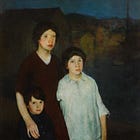Timely Connection
Can work on attention also influence the life of the physical body?
Continuing from:
The term “Time-body,” perhaps originating with Ouspensky (see below), and used periodically by Maurice Nicoll, may also be linked with “the state ‘I am’.”1 Nicoll says,
On one occasion I asked Gurdjieff, through an interpreter, whether it was necessary for everything to be overcome in oneself. He said: “No” and seemed then to speak in an indirect way more of the necessity of creating new attitudes to things so that, so to speak, it was comparable to crossing from one side to the other, as when crossing the road. I understood him to mean that if we remain with our present attitudes we are on one side but if we change attitudes we can go to the other side of ourselves. So I gathered that an attitude is always one-sided. He indicated that this was only possible if you took photographs of yourself. I heard at different times later on that taking photographs of oneself was different from merely observing oneself at any particular moment. If your quality of self-observation is sincere and if it is not merely done out of a sense of being told to do it, these observations become linked, collect together, and form gradually a photograph of yourself over a considerable period of time. I think that Ouspensky called this a Time-Photograph or possibly one photograph of your Time-Body. When you have a photograph of yourself in this sense you see yourself as a certain kind of person over many years, perhaps back to childhood, governed by certain attitudes. This increase of consciousness shews the possibility of taking everything in another way, so it could be compared to crossing over to the other side of yourself from that side that has hitherto governed you by means of typical one-sided attitudes . . .2




